Question
Problem 3 As a 401K retirement plan participant, you have to make personal decisions regarding your own investment objectives. Suppose you have $10,000 to divide
Problem 3
As a 401K retirement plan participant, you have to make personal decisions regarding your own investment objectives. Suppose you have $10,000 to divide among four investment alternatives in your 401K retirement plan. The investment alternatives and historical returns are as follows;
? Real Estate (RE) = 8%
? CD = 4% ? Mutual Fund (MF) = 6%
? Bonds = 7% You will follow the investment allocation guidelines below.
? More money should be in real estate than in CDs, at a rate of at least 2 to 1. [Hint: That means that RE > 2*CD]
? At least 50% ($5,000) must be in mutual funds and bonds combined.
? No more than 20% ($2,000) can be in bonds alone.
? At least 2.5% ($250) must be invested in each alternative.
? All of the $10,000 must be invested.
Questions:
a. (3 Points) In cell B3, use the Excel's built-in function named "SUMPRODUCT" to write a formula for the objective function. Be sure to reference the appropriate cells.
b. (4 Points) In cells B9:E9, enter the investment return coefficients for the objective function. Make sure the coefficients are input as proportions, not percentages.
c. (8 Points) In cells B12:E19, enter the constraint coefficients for each of the eight constraints.
d. (4 Points) In cells H12:H19, enter the appropriate constraint right-hand side values.
e. (8 Points) In cells F12:F19, use the "SUMPRODUCT" function to write a formula for the constraint left-hand side values. Be sure to reference the appropriate cells.
f. (5 Points) In cells G12:G19, write the type of inequality associated with each constraint using either "=," or "=."
h. (7 points) Setup Excel Solver to use it to solve the model for the maximum return. Keep the optimal solution returned by Solver in the model.

Step by Step Solution
There are 3 Steps involved in it
Step: 1

Get Instant Access to Expert-Tailored Solutions
See step-by-step solutions with expert insights and AI powered tools for academic success
Step: 2

Step: 3

Ace Your Homework with AI
Get the answers you need in no time with our AI-driven, step-by-step assistance
Get Started


